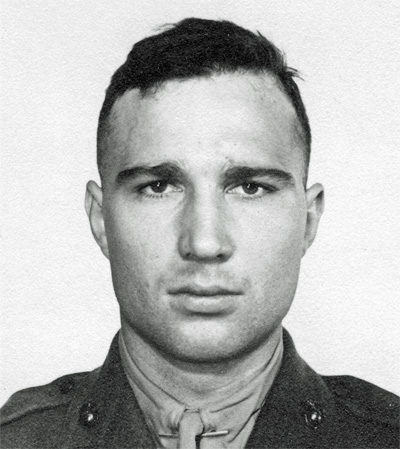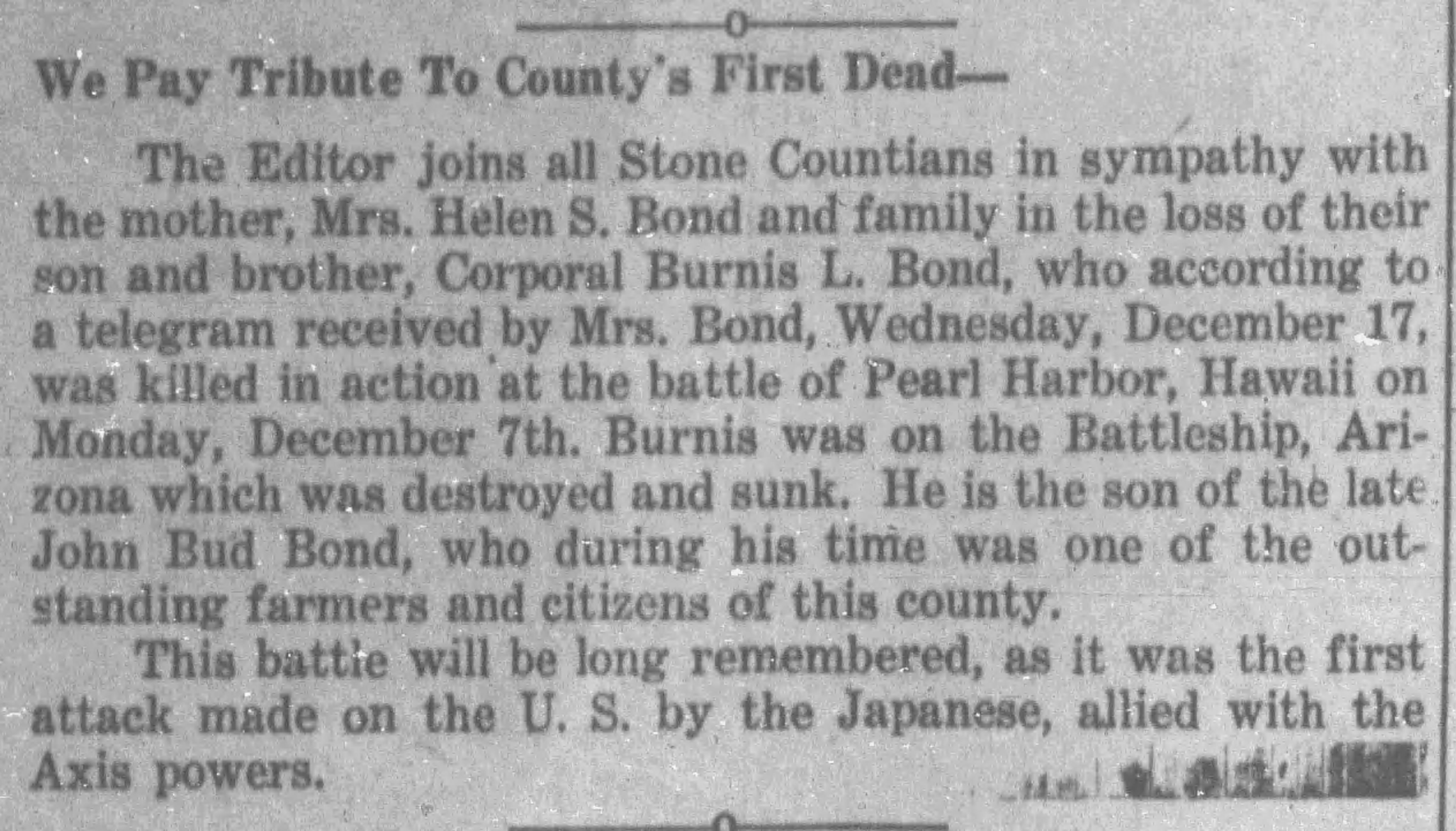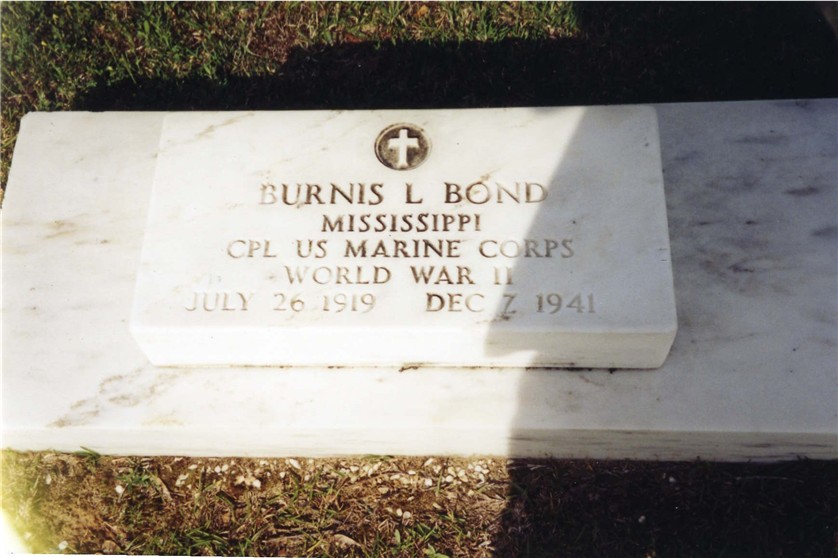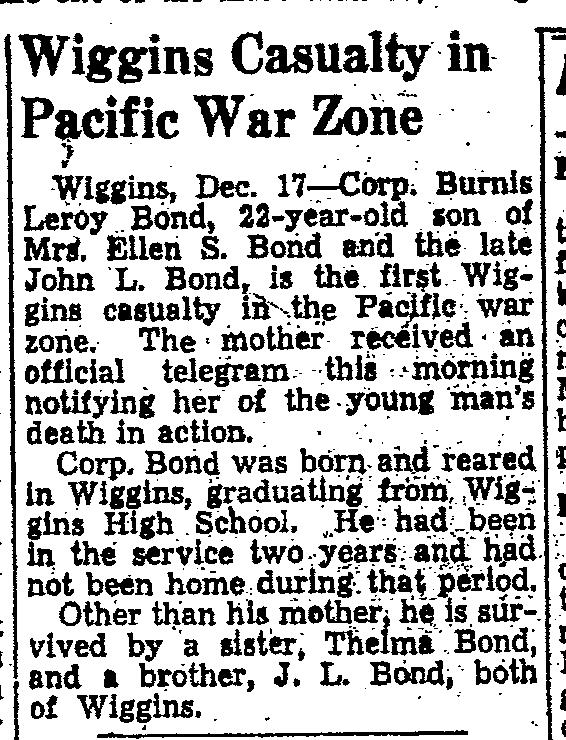As general quarters sounded, Baker and Nightingale, among the others, headed for their battle stations. Aft, congestion at the starboard ladder, that led through casemate no. 9, prompted Second Lieutenant Carleton E. Simensen, USMCR, the ship's junior Marine officer, to force his way through. Both Baker and Nightingale noted, in passing, that the 5-inch/51 there was already manned, and Baker heard Corporal Burnis L. Bond, the gun captain, tell the crew to train it out. Nightingale noted that the men seemed "extremely calm and collected.
As Lieutenant Simensen led the Marines up the ladder on the starboard side of the mainmast tripod, an 800-kilogram converted armor-piercing shell dropped by a Kate from Kaga ricocheted off the side of Turret IV. Penetrating the deck, it exploded in the vicinity of the captain's pantry. Sergeant Baker was following Simensen up the mainmast when the bomb exploded, shrapnel cutting down the officer as he reached the first platform. He crumpled to the deck. Nightingale, seeing him flat on his back, bent over him to see what he could do but Simensen, dying, motioned for his men to continue on up the ladder. Nightingale continued up to Secondary Aft and reported to Major Shapley that nothing could be done for Simensen.
An instant later, a rising babble of voices in the secondary station prompted Nightingale to call for silence. No sooner had the tense quiet settled in when, suddenly, a terrible explosion shook the ship, as a second 800-kilogram bomb -- dropped by a Kate from Hiryu -- penetrated the deck near Turret II and set off Arizona's forward magazines. An instant after the terrible fireball mushroomed upward, Nightingale looked out and saw a mass of flames forward of the mainmast, and much in the tradition of Private William Anthony of the Maine reported that the ship was afire *. "We'd might as well go below," Major Shapley said, looking around, "we're no good here." Sergeant Baker started down the ladder. Nightingale, the last man out, followed Shapley down the port side of the mast, the railings hot to the touch as they made their way below.
Baker had just reached the searchlight platform when he heard someone shout: "You can't use the ladder." Private First Class Kenneth D. Goodman, hearing that and apparently assuming (incorrectly, as it turned out) that the ladder down was indeed unusable, instinctively leapt in desperation to the crown of Turret III. Miraculously, he made the jump with only a slight ankle injury. Shapley, Nightingale, and Baker, however, among others, stayed on the ladder and reached the boat deck, only to find it a mass of wreckage and fire, with the bodies of the slain lying thick upon it. Badly charred men staggered to the quarterdeck. Some reached it only to collapse and never rise. Among them was Corporal Bond, burned nearly black, who had been ordering his crew to train out no. 9 5-inch/51 at the outset of the battle; sadly, he would not survive his wounds.
Shapley and Corporal Nightingale made their way across the ship between Turret III and Turret IV, where Shapley stopped to talk with Lieutenant Commander Samuel G. Fuqua, Arizona's first lieutenant and, by that point, the ship's senior officer on board. Fuqua, who appeared "exceptionally calm," as he helped men over the side, listened as Shapley told him that it appeared that a bomb had gone down the stack and triggered the explosion that doomed the ship. Since fighting the massive fires consuming the ship was a hopeless task.
Source: Travis Davis
Information contributed by NEIL O'CONNOR (48663429)
As general quarters sounded, Baker and Nightingale, among the others, headed for their battle stations. Aft, congestion at the starboard ladder, that led through casemate no. 9, prompted Second Lieutenant Carleton E. Simensen, USMCR, the ship's junior Marine officer, to force his way through. Both Baker and Nightingale noted, in passing, that the 5-inch/51 there was already manned, and Baker heard Corporal Burnis L. Bond, the gun captain, tell the crew to train it out. Nightingale noted that the men seemed "extremely calm and collected.
As Lieutenant Simensen led the Marines up the ladder on the starboard side of the mainmast tripod, an 800-kilogram converted armor-piercing shell dropped by a Kate from Kaga ricocheted off the side of Turret IV. Penetrating the deck, it exploded in the vicinity of the captain's pantry. Sergeant Baker was following Simensen up the mainmast when the bomb exploded, shrapnel cutting down the officer as he reached the first platform. He crumpled to the deck. Nightingale, seeing him flat on his back, bent over him to see what he could do but Simensen, dying, motioned for his men to continue on up the ladder. Nightingale continued up to Secondary Aft and reported to Major Shapley that nothing could be done for Simensen.
An instant later, a rising babble of voices in the secondary station prompted Nightingale to call for silence. No sooner had the tense quiet settled in when, suddenly, a terrible explosion shook the ship, as a second 800-kilogram bomb -- dropped by a Kate from Hiryu -- penetrated the deck near Turret II and set off Arizona's forward magazines. An instant after the terrible fireball mushroomed upward, Nightingale looked out and saw a mass of flames forward of the mainmast, and much in the tradition of Private William Anthony of the Maine reported that the ship was afire *. "We'd might as well go below," Major Shapley said, looking around, "we're no good here." Sergeant Baker started down the ladder. Nightingale, the last man out, followed Shapley down the port side of the mast, the railings hot to the touch as they made their way below.
Baker had just reached the searchlight platform when he heard someone shout: "You can't use the ladder." Private First Class Kenneth D. Goodman, hearing that and apparently assuming (incorrectly, as it turned out) that the ladder down was indeed unusable, instinctively leapt in desperation to the crown of Turret III. Miraculously, he made the jump with only a slight ankle injury. Shapley, Nightingale, and Baker, however, among others, stayed on the ladder and reached the boat deck, only to find it a mass of wreckage and fire, with the bodies of the slain lying thick upon it. Badly charred men staggered to the quarterdeck. Some reached it only to collapse and never rise. Among them was Corporal Bond, burned nearly black, who had been ordering his crew to train out no. 9 5-inch/51 at the outset of the battle; sadly, he would not survive his wounds.
Shapley and Corporal Nightingale made their way across the ship between Turret III and Turret IV, where Shapley stopped to talk with Lieutenant Commander Samuel G. Fuqua, Arizona's first lieutenant and, by that point, the ship's senior officer on board. Fuqua, who appeared "exceptionally calm," as he helped men over the side, listened as Shapley told him that it appeared that a bomb had gone down the stack and triggered the explosion that doomed the ship. Since fighting the massive fires consuming the ship was a hopeless task.
Source: Travis Davis
Information contributed by NEIL O'CONNOR (48663429)
Family Members
-
![]()
Olive Delila Bond Breland
1886–1967
-
![]()
Mary Arzone "Zona" Bond O'Neal
1887–1938
-
![]()
Calona Bond Breland
1889–1972
-
![]()
Nancy Arbelle Bond Hatten
1891–1973
-
![]()
Arthur M. Bond
1894–1898
-
![]()
Nellie Marcella Bond Taylor
1896–1951
-
![]()
Arkana Bond Hatten
1898–1959
-
![]()
Infant Daughter Bond
1901–1901
-
![]()
Thomas M. Bond
1902–1903
-
![]()
Frank Bond
1905–1986
-
![]()
Lottie Leota Bond Morrison
1908–1992
Sponsored by Ancestry
Advertisement
Advertisement

























